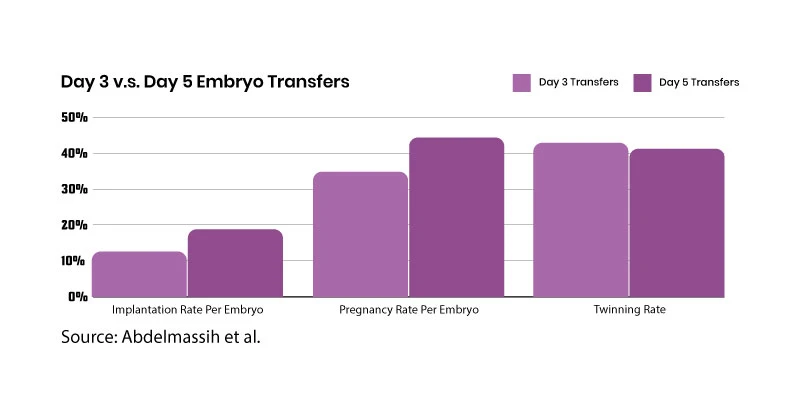Whether to transfer embryos at the Cleavage or Blastocyst stage has been one of the main decisions made during in vitro fertilization (IVF). The terms are more commonly stated as Day 3 and Day 5 respectively.
According to the American Society of Reproductive Medicine (ASRM), patients who have undergone Day 5 of the Embryo Transfer have a good chance of success. However, a few researchers are nonetheless concerned about the increased disadvantages associated with day 5 embryo transfers, although many patients have benefited from them. In this article, we will guide you on why Day 5 is considered the best for Embryo Transfer.
Blastocyst (Day 5) vs Cleavage Stage (Day 3): Understanding the Difference
An embryo that has matured for 5-6 days following fertilization is called a Blastocyst. The embryos are allowed to mature to this advanced stage before transfer. The doctors opt for the most fit embryos for implantation in the uterus at stage 5. At this point, the embryo is made up of two separate sections:
- A cluster of cells that will grow into the fetus
- A group of outer cells that will result in forming a placenta in the later stage.
Embryo formation starts from a single cell. It usually develops into a 6–8 cell known as Cleavage stage embryo by day 3. There are quite a few risks associated with the transfer on day 3 and hence after careful consideration, doctors decide on Embryo transfer.
Comparison of Day 3 vs Day 5 of Embryo Transfer
Even though days 3 and 5 of embryonic development are very close together, there is a big difference between these two phases of development. Embryos develop quickly. Every embryo originates from a single cell. After every 12 to 24 hours, each cell will divide into further more cells. Therefore, an embryo should consist of six to eight cells by the time it reaches day 3 of growth.
In just two days on day 5 the blastocyst forms. There will be between seventy and one hundred cells in an embryo. Approximately one-third of embryos are able to grow to the blastocyst stage.
How Successful is the Embryo Transfer on Day 5?
Some research was done at the National Library of Medicine by a private clinic on two groups of females. After the results, it was concluded that the day 5 transfer group had lower rates of multiple pregnancies and greater percentages of implantation and pregnancy.

Reasons Why Day 5 is Considered Best for Embryo Transfer
Greater Pregnancy Rates
Better pregnancy rates can be achieved by allowing the embryos more time to mature in a safe and controlled laboratory setting. Hence, research indicates that the likelihood of becoming pregnant is increased when blastocysts at day 5 are transferred rather than earlier-stage embryos.
Lower Risk of Multiple Pregnancies
Pregnancies that result in twins or triplets pose a greater risk to the health of the mother and the unborn children. Blastocyst transfer reduces the possibility of multiple pregnancies while maintaining high success rates by allowing for a single and healthy embryo transfer.
Improved Embryo Selection
The development of blastocysts at day 5 offers important information about the quality and viability of embryos. By monitoring the embryo’s growth to the blastocyst stage, doctors can more accurately determine the embryo’s likelihood of successful implantation.
Better Synchronization with the Uterine Lining
Better synchronization between the embryo and the uterine lining is possible when embryos are allowed to develop to the blastocyst stage. The uterus is ready for implantation by this time and resulting in a successful pregnancy.
Possibility of Freezing Embryos
Blastocysts have a higher survival percentage when frozen and thawed than earlier-stage embryos. At day 5, the best of the embryos can be preserved and one among them can be transferred into the uterus.
When to go for Embryo Transfer?
Many of you might be confused with this question when is the right time to go for embryo transfer, day 5 or day 3 which is better, or what are the advantages and disadvantages of the early transfer? Dont worry! Here is step by step procedure of how expert IVF doctors decide to choose the day for the embryo transplant.
- When any expert doctor goes for embryo transfer, they pay greater attention to the embryo’s quality than its developmental stage.
- The doctors select the greatest embryos for transfer that have the highest chance of implanting and developing into a healthy fetus.
- Even though embryos only have 4–8 cells on day 3, doctors set certain criteria for identifying the best embryos for a transfer process. If the cells and uterus wall of the female are healthy, the doctors transfer the cells on day 3 only.
- If the doctors have any doubts, they wait till day 5 for the embryo transfer.
- Hence, day 5 is considered a suitable stage for transfer by the doctors.
Advantages and Disadvantages of Day 5 Embryo Transfer?
| Advantages of Embryo Transfer on Day 5 | Disadvantages of Embryo Transfer on Day 5 |
| The embryos that don’t reach the blastocyst stage are eliminated | Only a few healthy embryos are available for the transfer |
| Higher-quality embryo is identified and transferred increasing the chances of conceiving | Day 5 transfers are not suggested to patients who are not able to produce many embryos |
| Higher implantation rate | |
| Genetic Testing can be done at this stage |
To Sum Up
It can be challenging to choose between day 3 and day 5 embryo transplants. It is a good as well as a bad fact that research hasn’t conclusively determined what is best for parents. Hence, it is still not sure that a day 5 embryo transfer is superior to a day 3 embryo transfer. It depends on several other factors and doctors make an informed decision for every patient.
It’s best to talk to your fertility doctor about all of your healthcare plans. You can always discuss your fertility treatment choices with our expert doctors at Crysta IVF. Get the best personalized solution for all kinds of pregnancy-related problems with our expert doctors.
Frequently Asked Questions
Ques: Is embryo transfer better on day 3 or day 5?
Day 5 transfer is generally more effective if you have sufficient good-quality embryos, as blastocysts have higher implantation rates and attach better with the uterine lining.
Ques: Which day is better for embryo transfer?
For most patients, day 5 is better if the lab can culture the embryos to the blastocyst stage successfully. It offers higher success rates.
Ques: Is a 5-day embryo transfer better?
Yes. Research has suggested that a 5-day embryo transfer is better than a day 3 transfer in terms of implantation rate.
Ques: What should I feel after 5 days of embryo transfer?
Many women can experience cramps and pain after embryo transfer. The breasts become tender and some women might experience morning sickness.
Ques: How Quickly a Day 5 Embryo Implant in Uterus?
When human blastocysts are transferred by in vitro fertilization (IVF), the fertilized eggs often emerge from their shell and begin to implant one or two days after day 5 of the process. This indicates that the implantation occurs approximately 7–8 days following egg fertilization.
Ques: How many embryos reach day 5?
According to RMA, research has concluded that 30 to 40% of embryos make it to the blastocyst stage or day 5.
Ques: How to increase the success rate of an embryo transfer?
To increase the success of embryo transfer, women must:
- Take rest and relax
- Take your prescribed medications on time
- Avoid going for vigorous exercise
- Eat a healthy and vitamin-rich diet
Ques: What are the benefits of a day 5 embryo transfer?
A day 5 (blastocyst) transfer allows the embryo to grow longer in the lab, so only the strongest embryos are selected for transferring into the mother’s uterus. This improves the chances of implantation.
Ques: Why do embryos stop developing after day 3?
After day 3, the embryo’s own DNA takes over (maternal-to-embryonic transition). If there are genetic or chromosomal problems, the embryo may stop dividing at this stage, which is nature’s way of preventing the implantation of unhealthy embryos.
Ques: Can a 5-day blastocyst split into twins?
Yes, it is possible, but it happens rarely. A single blastocyst can split into two identical embryos, resulting in identical (monozygotic) twins.
Ques: Is a 5AA embryo more likely to be a boy?
No. A 5AA grade refers to the quality and development of the embryo, not its sex. Both male and female embryos can have excellent 5AA grades.




